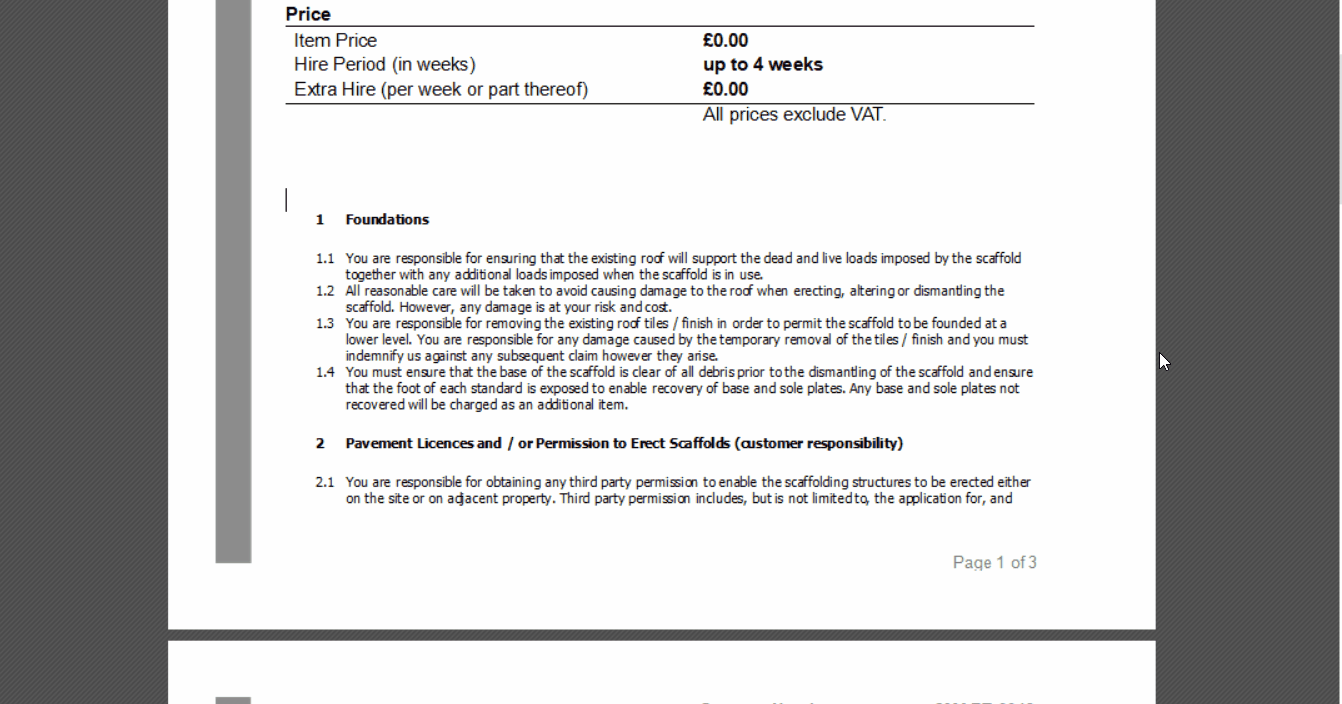-
Overview of the Clauses & Conditions
Each quotation may include a list of SMARTText Clauses (Sometimes called Conditions or Qualifications). These clauses are blocks of predefined text that appear or disappear automatically.
For example, if you have a Temporary Roof within the item, all of the clauses for Temporary Roofs will be automatically displayed on the Quotation.

-
Differences between Clauses & Conditions
SMART Estimator Quote IT differentiates between “clauses” and “conditions”. Clauses are associated with a single item in the project. They may be different for every project item. While Conditions are added to the project itself. These are usually standard blocks of text added to every quotation.

-
Where to find Clauses & Conditions
Clauses
The Clauses SMARTText can usually be found within the Item Description Section. From here, you should see the placeholder [CLAUSES] SMARTText if you do not have any items or Clauses already contained within the Item Description (For example, Temporary Roofs).
Conditions
The Conditions SMARTText can be found within the Terms & Conditions Section. You should either see the placeholder [TERMS AND CONDITIONS] SMARTText or Conditions are already within the section.
-
How to access the Clauses & Conditions
In order to modify the Clauses & Conditions in your quotation, we will need to access the set of tools utilised for allocating the clauses. You can access these tools by clicking on the Clauses SMARTText or the Terms and Conditions SMARTText. The Clauses & Conditions Dialog Box will appear with some tools:
Understanding the Table
All Clauses & Conditions are displayed in a table. In the table, each entry is organised by Group, which represents the underlying category. The table can be scrolled down using your mouse wheel or through the scrollbar.
Each Clause & Condition in each group is listed with its Name. It also has a Tick Box indicating whether the clause is selected and should be included in the quotation, along with a Description displayed on the quotation if it is selected.
Filtering Options
By default, you will see all the clauses available for you to select. You may narrow down the list of clauses & conditions by choosing one of three viewing options.
- All Clauses (or All Conditions)
- Clauses Selected for this Item (or Conditions Selected for this Project)
- Recommended Clauses (or Recommended Conditions)
This is the default view that shows every Clause (or Condition) regardless of whether they are selected or not.
This view will only show the Clauses (or Conditions) you have selected to appear on the quotation. When deselecting a Clause (or Condition), you may find this view useful.
This view is empty by default. This includes clauses that are not automatically selected, but have been Marked as Recommended for a given item or project.
-
Selecting the Clauses & Conditions
Now you can select the Clauses or Conditions for the quotation by clicking on the Tick Boxes to select the clauses you want to include in the quotation. Be sure to review each clause’s description before finalising your selection to ensure that it is applicable.
Once you’re satisfied with the Clauses & Conditions you want included into the quotation, click on the Green Tick button on the top right of the dialog box to confirm your changes.
-
Amending the Clauses & Conditions
You can amend any of the Clauses & Conditions by clicking on the Description Box of the Clause or Condition you want to amend. A new dialog will appear for you to edit the text and do basic operations such as Bolding, Italicizing and Underlining, alongside advanced operations such as Bullet Points, Font size and type, alignment and inserting images.
If you are satisfied with the changes, you may confirm them by clicking the Green Tick button in the top right corner of the dialog box. At this point, your amended Clause or Condition will appear on your quotation.
SMART Estimator
What’s new?
Getting Started
Setup and Configuration
-
Enterprise Server
-
Cloud Server Setup
Local Windows Server Setup
Adding Cloud server users
Server Back Up and Restore
Archiving Estimates from server
Migrating Local server to Cloud
Creating Folders in Enterprise Server
Using Server Tools from the Command Line
-
User software settings
User Address Settings and Yard
Scaffold Banner and Sheeting logo
Adding Watermarks
-
Setting up your Rates
Editing Shared Pricing Rates
Creating a rate setting template project
Importing and Exporting shared Rates
Creating an Estimate
Importing Drawings and Models
Scheduling Scaffolds
Creating 3D Scaffolds
-
3D Model Controls
Adding Independent scaffolds
Adding Circular Tank scaffolds
Adding Birdcage & Lift shaft scaffolds
Adding Tied or Freestanding towers
Adding Stair towers, Ladders towers & Buttresses
Adding Loading bays
Adding Chimney scaffolds
Adding Temporary Roof
Adding Edge protection
Adding Pavement Gantry’s
System Scaffolds
Safety Decking
Using the Scaffold Library
Editing Scaffolds
Scaffold Add-ons & Options
-
Adding Gin wheels, Rubbish Chutes, Safety standards, Double standards and Lamps
Adding and Editing bridges/beam work
Adding Beams around Corners
Adding Cladding
Adding Cantilever protection fans
Adding Pavement Lifts
Adding Recesses and Infills
Building and Ground colour
Visual options (Tube, Ladder, System details and Grips)
Add a Pedestrian or Scaffolder
Copying pictures of the model
Material Lists and Drawings
Pricing and Estimation
Quotations
Enterprise Server
Troubleshooting














